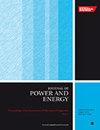基于伴随的跨声速风扇叶片气动结构设计优化
IF 1.1
4区 工程技术
Q3 ENGINEERING, MECHANICAL
Proceedings of the Institution of Mechanical Engineers, Part A: Journal of Power and Energy
Pub Date : 2023-09-01
DOI:10.1177/09576509231162169
引用次数: 0
摘要
本文提出了一种新的优化方法,以最大限度地提高现代风扇叶片的气动效率,同时满足材料限制所施加的结构约束。采用响应面法对结构应力进行结构约束,建立了基于离散伴随矩阵的气动效率灵敏度评价方法。为了便于生成响应面所需的大量采样点,采用了一种快速、无网格的应力计算方法。该方法被应用于一个实际的风扇叶片的优化,代表现代,大涵道比涡扇喷气发动机。结果表明,以钛合金材料为例,在保持应力低于规定值500 MPa的情况下,风扇叶片效率可提高0.6%。结果表明,在没有应力约束的情况下,效率效益较大,为0.9%,但最大应力值大大超出了材料的可接受准则,几乎达到1000 MPa。该方法是建立在一个模块化的方式,可以适应各种不同的涡轮机械叶片设计。由于其实际意义,对优化后的风扇叶片进行了颤振分析。本文章由计算机程序翻译,如有差异,请以英文原文为准。
Adjoint based aero-structural design optimisation of a transonic fan blade
A novel optimisation process has been proposed in this paper to maximize the aerodynamic efficiency of a modern fan blade while satisfying the structural constraint imposed by the material limits. The method developed is based on the discrete adjoint for the aerodynamic efficiency sensitivity evaluation with the structural constraint provided by a response surface method for the structural stress. To facilitate a large number of sampling points required in the response surface generation, a fast, meshless method was used for the stress calculations. The method was applied to the optimisation of a practical fan blade, representative of modern, high-bypass-ratio turbofan jet engines. It is demonstrated that the fan blade efficiency can be improved by 0.6% while maintaining the stress below a prescribed value of 500 MPa assuming a titanium alloy material. It is shown that without the stress constraint, the efficiency benefit is larger, namely 0.9% but the maximum stress value increases considerably beyond the material’s acceptable criterion, to almost 1000 MPa. The method is built in a modular way and can be adapted to accommodate a range of different turbomachinery blade designs. Flutter analysis for the optimised fan blade has also been carried out due to its practical importance.
求助全文
通过发布文献求助,成功后即可免费获取论文全文。
去求助
来源期刊

CiteScore
3.30
自引率
5.90%
发文量
114
审稿时长
5.4 months
期刊介绍:
The Journal of Power and Energy, Part A of the Proceedings of the Institution of Mechanical Engineers, is dedicated to publishing peer-reviewed papers of high scientific quality on all aspects of the technology of energy conversion systems.
 求助内容:
求助内容: 应助结果提醒方式:
应助结果提醒方式:


